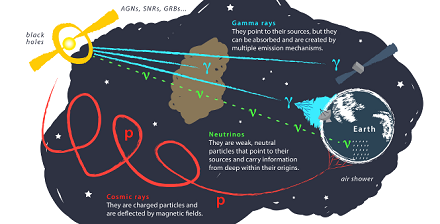Credits: Juan Antonio Aguilar & Jamie Yang, IceCube/WIPAC
In the last 100 years, thanks to a fast development of new observational techniques and new theories, we made a huge leap forward in our understanding of the cosmic rays (CR) and their potential sources. With the advent of the very-high-energy (VHE) gamma-ray and neutrino astronomy the potential to directly probe the most energetic cosmic processes became a reality. Still several key questions remain unanswered: What are the sources of high-energy CRs and neutrinos? Is the neutrino and CR emission constant in time or transient? To which extent the so-far proposed hadronic emission models can explain the observed data? It is by now clear that a single instrument is not able to answer them and we have to rely on the multimessanger approach, where several instruments, sensitive to different particles and energy ranges, coordinate their observations, exchange data, and interpret them together. One example of such an approach is the collaboration between the Major Atmospheric Gamma-ray Imaging Cherenkov telescopes (MAGIC) and the IceCube neutrino detector. Similar programs are also implemented by the VERITAS and H.E.S.S. experiments.
The chance of discovering extraterrestrial neutrino point sources largely varies with the phenomenology of the accelerators and of their emission models. Coordinated observation of gamma-rays and neutrinos might be possible for sources where hadronic p-p or p-γ interactions take place. This concerns variable objects as Blazars or FSRQs, as well as Galactic systems like microquasars and magnetars, whose emission is interpretable with hadronic models. In all cases, the availability of simultaneous information on high-energy gamma-ray emission and neutrinos is crucial.
IceCube is a 1 km3 neutrino telescope located at the South Pole. The detector is continuously operated with only very minimal downtime, and has a full sky field of view, with energy sensitivity depending on declination. It has also several real time analysis systems which take care of the event selection, data transfer and generation of alerts for external observatories, all within a median delay of 20 s after the event detection. They are all optimized for slightly different event types, the Gamma-ray Follow-Up (GFU), High Energy Starting Events (HESE) and Extremely High Energy (EHE) being the most interesting alert channels for the gamma-ray community.
The MAGIC and IceCube groups at DESY have been collaborating strongly on developing the GFU program since it was first proposed in 2009. GFU searches for neutrino flares from known VHE gamma-ray sources using advanced machine learning techniques and a smart time-clustering algorithm. From its inauguration in 2012, 14 GFU alerts were send by IceCube, but due to unfavorable observational conditions only one was followed-up by MAGIC.
The HESE and EHE streams are publicly available from April and July 2016 respectively. They both aim at selecting the most energetic and most likely astrophysical neutrino events. MAGIC followed-up two of the five alerts issued till Nov 2016. No gamma-ray signal was detected.
| Results on the topic from the group |





